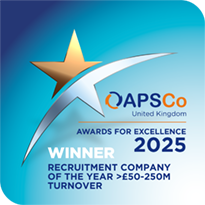Recruitment organisations play a vital role in the world of employment, helping both candidates and employers find the right people for their jobs to help them grow their businesses.
How does a recruitment service actually work though? What’s involved in finding those candidates to help people progress in their careers?
In this blog we take you behind the scenes, to see a typical week working in recruitment.
Understanding the role of a recruitment partner
A recruitment organisation matches candidates with employers, although as you’ll find out below there’s a lot more to it than that.
If you're looking for a new job, there are lots of ways to do it: you can go through a recruitment organisation or apply directly with a company. Where companies want to ensure they can reach a diverse range of candidates and attract the most experienced applicants, they’ll often partner with a recruitment organisation to extend their reach.
Understanding the recruitment process
Starting the conversation
All new job vacancies start with a conversation between the employer and the recruiter who’ll be working on the role. That’s because it is about more than just capturing a list of duties that the new recruit will be responsible for delivering.
To identify the right candidates the recruiter will want to understand what the company’s culture is like, the strategic direction of their business and their approach to diversity and inclusion. As well as how the business operates, how they nurture people and what opportunities there are for professional and personal progression.
Promoting the job
Once the recruiter fully understands all the key elements needed to find the right person, their attention turns to writing the job advert.
This shouldn’t be a complete copy of the job description, but instead a chance to explain more about the business and role – to give candidates insight into what they can expect if they were to take on the job.
Then it’s straight to work seeking out potential candidates. Recruiters will be able to draw on a comprehensive database of candidates who have already expressed interest in a new role.
When it comes to advertising the vacancy, the recruiter will carefully consider the best channels through which to promote the role. This could include nationwide online job boards which they know receive a steady volume of traffic from people job searching, and local targeted strategies that ensure they’re able to reach specialist skills.
Shortlisting candidates
Once the applications start coming in, the recruitment team will then work through each application to assess the candidate’s potential suitably for the role being advertised. Chatting with them to understand their past experience, what they’re looking for from the role and sharing more information about the employer and their plans for the new recruit. Pulling together a shortlist of candidates for the employer to interview.
Onboarding the new recruit
Once the employer settles on the right candidate for their position, the recruiter will support them to facilitate an official offer of employment and work through any onboarding required.
Depending on the industry the candidate will be working within, the recruitment organisation may also support employers by undertaking security checks and clearance – to ensure all the measures are in place to start them in their new role.
Where workers are being placed on temporary assignments, the recruiter will work with their administration and compliance colleagues to ensure any reference checks and paperwork is completed. Before setting the worker up through whichever pay model they have decided works best for them – which typically includes Pay As You Earn (PAYE), Umbrella and Limited Company.
A typical day in a recruitment organisation
No day is the same. Sometimes there’s a busy rush to finalise a large volume of candidates to start in their roles – whilst other days are spent on the phone chatting with potential candidates about job openings and searching through hundreds of CVs.
As well as updating job adverts and checking in with employers to make sure they’re well supported throughout the hiring process.
There’s also plenty of opportunity to build relationships with employers and help them to advance their strategic business goals. From growing their teams, to extending their service capability to allow them to deliver more work and projects for their clients. A good working partnership between an employer and their recruitment partner should support the current and future needs of their business – providing a wealth of opportunities for new people to join their company.
Interested in working in recruitment?
You can find out more about how you could start your career in recruitment with NRL by visiting our dedicated page.


.png)


.png)


